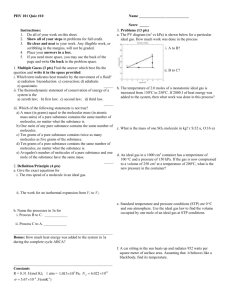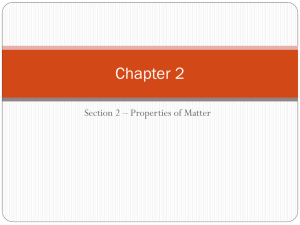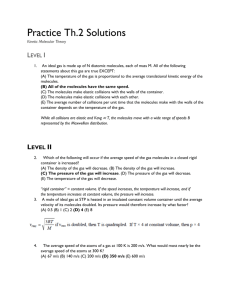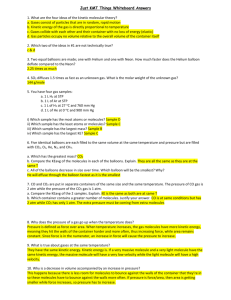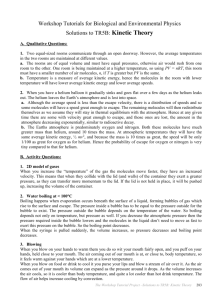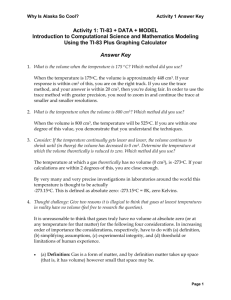Answerschapter 13 and 14 physics MC 2012
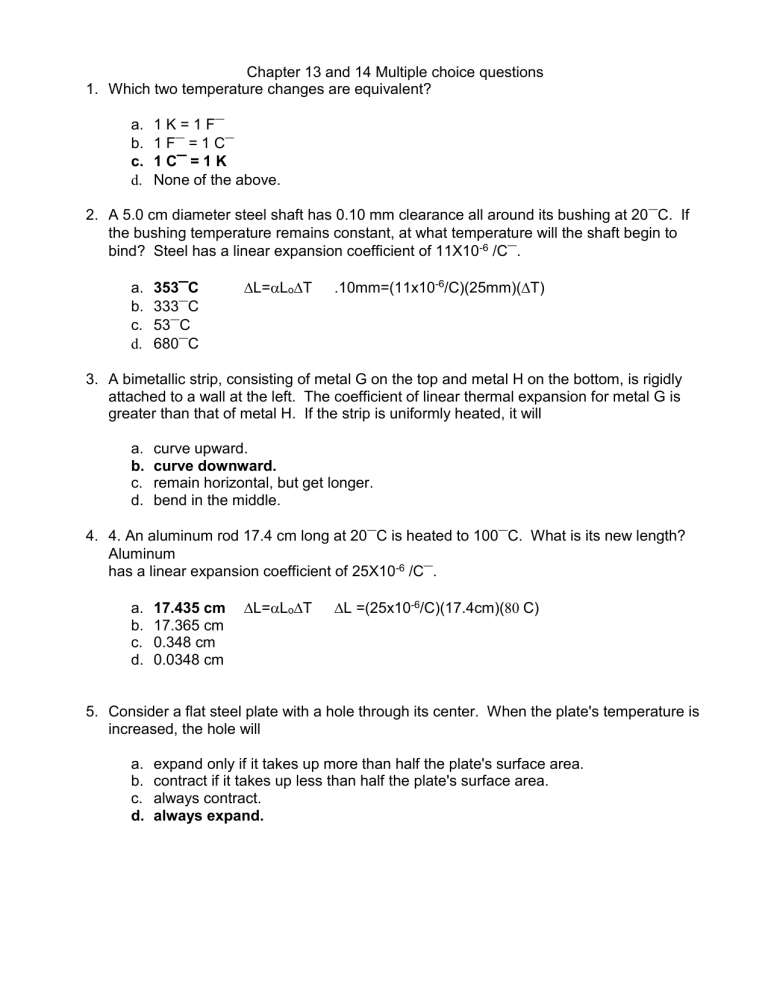
Chapter 13 and 14 Multiple choice questions
1. Which two temperature changes are equivalent? a. 1 K = 1 F ¯ b. 1 F ¯ = 1 C ¯ c. 1 C ¯ = 1 K d.
None of the above.
2. A 5.0 cm diameter steel shaft has 0.10 mm clearance all around its bushing at 20 ¯ C. If the bushing temperature remains constant, at what temperature will the shaft begin to bind? Steel has a linear expansion coefficient of 11X10 -6 /C ¯ .
L=
L o
T .10mm=(11x10 -6 /C)(25mm)(
T) a. 353 ¯ C b. 333 ¯ C c. 53 ¯ C d.
680 ¯ C
3. A bimetallic strip, consisting of metal G on the top and metal H on the bottom, is rigidly attached to a wall at the left. The coefficient of linear thermal expansion for metal G is greater than that of metal H. If the strip is uniformly heated, it will a. curve upward. b. curve downward. c. remain horizontal, but get longer. d. bend in the middle.
4. 4. An aluminum rod 17.4 cm long at 20 ¯ C is heated to 100 ¯ C. What is its new length?
Aluminum has a linear expansion coefficient of 25X10 -6 /C ¯ . a. 17.435 cm
L=
L o
T
L =(25x10 -6 /C)(17.4cm)(
C) b. 17.365 cm c. 0.348 cm d. 0.0348 cm
5. Consider a flat steel plate with a hole through its center. When the plate's temperature is increased, the hole will a. expand only if it takes up more than half the plate's surface area. b. contract if it takes up less than half the plate's surface area. c. always contract. d. always expand.
6. If the pressure acting on an ideal gas at constant temperature is tripled, its volume is a. reduced to one-third. b. increased by a factor of three. c. increased by a factor of two. d. reduced to one-half.
7. An ideal gas occupies 400 cm 3 at an absolute pressure of 250 kPa. If the volume is changed to 100 cm 3 at constant temperature, what will be the new gauge pressure? a. 1000 kPa b. 899 kPa (250 kPa) 400 cm 3 = 1000 kPa c. 164 kPa 100 cm 3 d. 62.5 kPa A decrease in volume at constant temperature
causes an increase in presssure
8. An ideal gas occupies 600 cm 3 at 20 ¯ C. At what temperature will it occupy 1200 cm 3 if the pressure remains constant? a. 10 ¯ C 600 cm 3 = 1200 cm 3 x=586 K b. 40 ¯ C 293 K x
– 273 313 o C c. 100 ¯ C d. 313 ¯ C
9. The dimension of PV is N m 3 = N m = J m 2 a. [force] b. [ energy] c. [energy/temperature] d. [Force/Temperature]
10. A container holds N molecules of an ideal gas at a given temperature. If the number of molecules in the container is increased to 2N with no change in temperature or volume, the pressure in the container a. doubles. PV=nRT Pressure is directly related to volume b. remains constant. c. is cut in half. d. None of the above.
11. According to the ideal gas Law, PV = constant for a given temperature. As a result, an increase in volume corresponds to a decrease in pressure. This happens because the molecules a. collide with each other more frequently. b. move slower on the average. c. strike the container wall less often. d. transfer less energy to the walls of the container each time they strike it.
12. Oxygen molecules are 16 times more massive than hydrogen molecules. At a given temperature, the average molecular kinetic energy of oxygen, compared to hydrogen a. is greater. b. is less. c. is the same. K.E. average = 3/2 K b
T - therefore K.E. is only temperature dependent d. cannot be determined since pressure and volume are not given.
13. If the temperature of a gas is increased from 20 ¯ C to 40 ¯ C, by what factor does the speed of the molecules increase? a. 3% v = 3/2 RT ( 313 K – 293 K * ) 100 = 3.4 % b. 30% M
293 K c. 70% d. 100%
14. A sample of an ideal gas is heated and its Kelvin temperature doubles. What happens to the average speed of the molecules in the sample? a. It does not change. b. It doubles. c. It halves. d. None of the above. The average speed increases by the square root of 2.
15. The absolute temperature of an ideal gas is directly proportional to which of the following? a. speed b. momentum c. kinetic energy d. mass
K.E.=3/2 K
B
T
16. In order to double the average speed of the molecules in a given sample of gas, the temperature (measured in Kelvins) must a. quadruple. b. reduce to one-fourth its original value. c. reduce to one-half its original value. d. double.
17. A molecule has a speed of 500 m/s at 20 ¯ C. What is its speed at 80 ¯ C? a. 500 m/s (80 o C + 273) 500m/s = 549 m/s b. 550 m/s (20 0 C + 273) c. 1000 m/s d. 2000 m/s
18. What temperature is the average kinetic energy of an atom in helium gas equal to
6.21X10
-21 J? a. 200 K K.E.=3/2 K
B
T 2 6.21x10
-21 J = 300 k b. 250 K 3 1.38x10
-23 J/K c. 300 K d. 350 K
19. A container holds oxygen and helium gases at the same temperature. Which one of the following statements is correct? a. The oxygen molecues have the greater kinetic energy. b. The helium molecules have the greater kinetic energy. c. The oxygen molecules have the greater speed. d. The helium molecules have the greater speed. V = 3 R T
M
20. The molecular kinetic energy of a gas can be determined by knowing only a. the number of molecules in the gas. b. the volume of the gas. c. the pressure of the gas. K.E. = 3/2 k b
T d. the temperature of the gas.
21. A container is filled with a mixture of helium and oxygen gases. A thermometer in the container indicates that the temperature is 22 ¯ C. Which gas molecules have the greater average speed? a. The helium molecules do because they are monatomic. b. It is the same for both because the temperatures are the same. c. The oxygen molecules do because they are more massive. d. The helium molecules do because they are less massive.
22. A cup of water is scooped up from a swimming pool of water. Compare the temperature
T and the internal energy U of the water, in both the cup and the swimming pool. a. T
Pool
is greater than T
Cup
, and the U is the same. b. T
Pool
is less than T
Cup
, and the U is the same. c. T
Pool
is equal to T
Cup
, and U
Poo l is greater than UCup . d. T
Pool
is equal to T
Cup
, and UPool is less than UCup.
23. Gasoline yields 4.8X10
7 joules per kg when burned. The density of gasoline is approximately the same as that of water, and 1 gal = 3.8 L. How much energy does your car use on a trip of 100 mi if you get 25 mi per gallon? a. 3.7X10
8 J 4 gal ( 3.8 L ) ( 1 kg ) 4.8 x10 7 J = b. 4.6X10
8 J ( 1 gal ) ( 1 L ) K c. 6.2X10
8 J d. 7.3X10
8 J
28. The internal energy of an ideal gas depends on a. its volume. b. its pressure. c. its temperature. d. all of the above.
29. An ideal gas at STP is first compressed until its volume is half the initial volume, and then it is allowed to expand until its pressure is half the initial pressure. All of this is done while holding the temperature constant. If the initial internal energy of the gas is U, the final internal energy of the gas will be a. U. b. U/3. c. U/2. d. 2U.
30. Heat is added to an ideal gas at 20 ¯ C. If the internal energy of the gas increases by a factor of three during this process, what is the final temperature? a. 60 ¯ C b. 66 ¯ C c. 600 ¯ C U=3/2 NkT d. 606 ¯ C or U = 3/2 nRT
31. The water flowing over Niagara Falls drops a distance of 50 m. Assuming that all the gravitational energy is converted to thermal energy, by what temperature does the water rise? a. 0.10 C ¯ b. 0.12 C ¯ G.P.E = Q mgy = m c T gy = c T c. 0.37 C ¯ 9.8 m/s 2 (50m)=
.12 oC d. 0.42 C ¯ 4180 J/Kg

